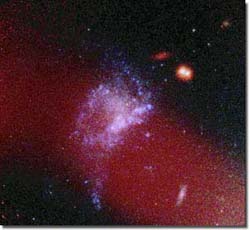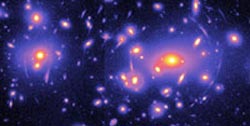This area deals with the fundamental laws and building blocks of nature and how they interact, the properties and the behavior of matter, and research into space and time and their structures.
innovations-report provides in-depth reports and articles on subjects such as astrophysics, laser technologies, nuclear, quantum, particle and solid-state physics, nanotechnologies, planetary research and findings (Mars, Venus) and developments related to the Hubble Telescope.

New ultraviolet observations indicate a Milky Way star is spinning nearly 200 times faster than Earth’s sun, the probable result of a merger between two sun-like stars whose binary orbit recently collapsed, according to a University of Colorado at Boulder astronomer.
The yellow giant, known as FK Comae Berenices, or FK Com, is 10 times larger than the sun and is emitting spectacular amounts of X-rays, ultraviolet light and radio waves as it rotates furiously, said Senior Resea

Astronomers have discovered how ominous black holes can create life in the form of new stars, proving that jet-induced star formation may have played an important role in the formation of galaxies in the early universe.
This false-color image incorporates infrared data (invisible to the human eye). The blue regions (essentially the whole of Minkowski’s Object) show enhanced star formation. The red background galaxy and two red foreground stars appear in sharp contrast. The red over

Astronomers say a dusty disc swirling around the nearby star Vega is bigger than earlier thought. It was probably caused by collisions of objects, perhaps as big as the planet Pluto, up to 2,000 kilometers (about 1,200 miles) in diameter.
NASA’s Spitzer Space Telescope has seen the dusty aftermath of this “run-in.” Astronomers think embryonic planets smashed together, shattered into pieces and repeatedly crashed into other fragments to create ever-finer debris. Vega’s l

A team of scientists from the University of Delaware has discovered that brown dwarfs–celestial bodies that are often referred to as failed stars–can be surrounded by clouds of very hot and very cool gas.
The UD research team of John E. Gizis, assistant professor of physics and astronomy, Harry L. Shipman, Annie Jump Cannon Chair of Physics and Astronomy, and James A. “Rusty” Harvin, researcher in physics and astronomy, used the Hubble Space Telescope to show for the first time

Hubble Space Telescope data, analyzed by a Yale astronomer using gravitational lensing techniques, has generated a spatial map demonstrating the clumped substructure of dark matter inside clusters of galaxies.
Clusters of galaxies (about a million, million times the mass of our sun), are typically made up of hundreds of galaxies bound together by gravity. About 90 percent of their mass is dark matter. The rest is ordinary atoms in the form of hot gas and stars.
Althou

To understand our planet’s magnetic field, Wisconsin scientists are studying a ball of molten metal
In an underground bunker that brushes up against a barnyard on one side and a cornfield on the other, scientists from the University of Wisconsin, Madison, are trying to solve an enduring cosmic mystery: how does the Earth generate its magnetic field–the vast, invisible web that shapes the aurora, makes compass needles point north, and shields us from solar storms? And how do simi